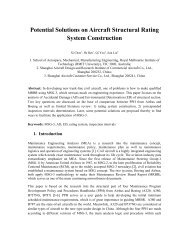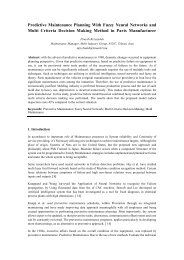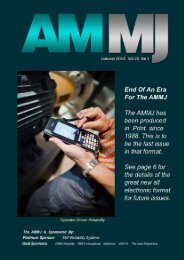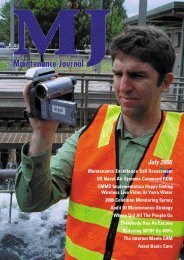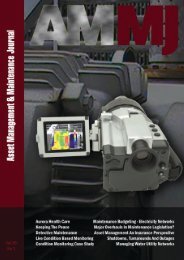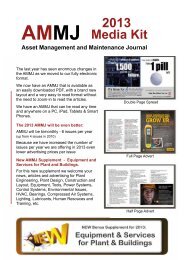July - AMMJ
July - AMMJ
July - AMMJ
You also want an ePaper? Increase the reach of your titles
YUMPU automatically turns print PDFs into web optimized ePapers that Google loves.
<strong>AMMJ</strong><br />
Effective Thickness of Corroded Steel Plates 39<br />
2.0 Problem Statement<br />
Some researchers have done some experimental studies and detailed investigations of the corroded surfaces<br />
to introduce methods for estimating the remaining strength capacities of corroded tensile steel plates. Namely,<br />
Matsumoto et al. (1989) investigated the tensile strength, using tensile coupons with corrosion and predict the<br />
remaining tensile strength of the corroded plates, using the minimum value of average thickness (t sa ) of the cross<br />
section perpendicular to the loading axis as a representative thickness. Further, Muranaka et al. (1998) and Kariya<br />
et al. (2003) proposed different representative thickness parameters with a correlation of average thickness (t avg )<br />
<br />
and standard deviation of thickness ( st), to estimate the tensile strength of corroded members based on te<br />
many _ y <br />
tensile tests.<br />
<br />
Thus, it is very clear that, many researchers usually use representative thickness based on several statistical<br />
parameters to estimate the remaining strength. The all above described representative thickness concepts were<br />
derived with relation to the average thickness of the corroded plate (t avg ) which eventually depends on the accuracy<br />
of the thickness measurements. But, it is not easy to conduct bridge inspections with detailed investigations for each<br />
and every structure in regular basis as the number of steel bridge infrastructures in the world is steadily increasing<br />
as a result of building new steel structures and extending the life of older structures. Therefore, it is important to<br />
establish a simple and accurate procedure to predict the remaining strength capacities of a corroded steel member<br />
by measuring lesser number of points with an acceptable accuracy level. So, the objective of this paper is to present<br />
a remaining strength estimation method by using a representative effective thickness which is related with an easily<br />
measurable dimension like initial thickness (t 0 ), minimum thickness (t min ), etc.<br />
3.0 Experimental Investigation<br />
3.1 Measurement of Corroded Surface<br />
Py<br />
<br />
( yn / y ) ( bn / b ) yn y t eff = t 0 + (1-) t min () <br />
B<br />
y <br />
In this study, 42 specimens (21 each from web and flange) cut out from a girder of Ananai River in Kochi Prefecture<br />
on the shoreline of the Pacific Ocean, which had been used for about hundred years. It was constructed as a railway<br />
bridge in 1900, and in 1975 changed to a pedestrian bridge, when the reinforced concrete slab was cast on main<br />
girders. The bridge was dismantled due to serious corrosion damage in year 2001. Further, four corrosion-free<br />
specimens were cut down smoothly from both sides of corroded steel plate also fabricated in order to clarify the<br />
material properties. The JIS No.5 test specimen is shown in Figure 1.<br />
<br />
Figure 1<br />
JIS No. 5 Specimen for tensile test<br />
Before conducting the thickness measurements, the<br />
rust and paint on the surface were removed by using<br />
a steel wire brush and then applying high pressure<br />
water carefully in order to not change the condition<br />
of the corrosion irregularity. Then the thicknesses of<br />
all scratched specimens were measured by using<br />
a laser displacement gauge and the intervals of<br />
measurement data are 1mm and 0.3 mm in X and Y<br />
directions respectively. The measurement performed<br />
shaded area (70mm x 25mm) is shown in Figure<br />
1 and the condition of thickness measurement is<br />
shown in Figure 2. Then, the statistical parameters<br />
such as average thickness (t avg ), minimum thickness<br />
(t min ), standard deviation ( st ) and coefficient<br />
of variability (CV) were calculated from the<br />
measurement results.<br />
3.2 Outline of Tensile Test<br />
Py<br />
<br />
( yn / y ) ( bn / b ) yn y t eff = t 0 + (1-) t min () te<br />
_ y <br />
By<br />
<br />
The extensometer which can be used to measure<br />
elongation until maximum load was set between two<br />
marked points as shown in Figure 3 for all 42<br />
Figure 2<br />
Condition of thickness measurement<br />
Vol 24 No 3<br />
te _ b




